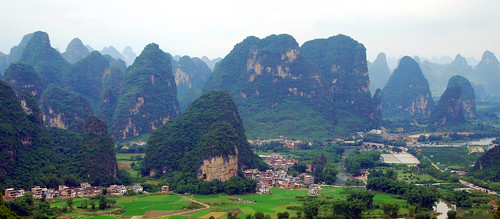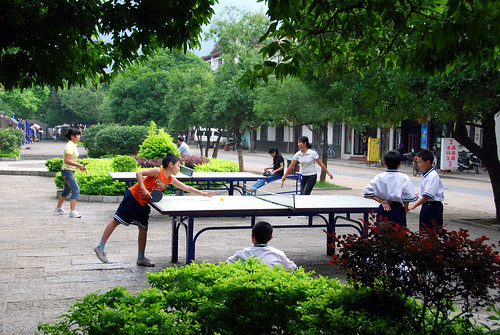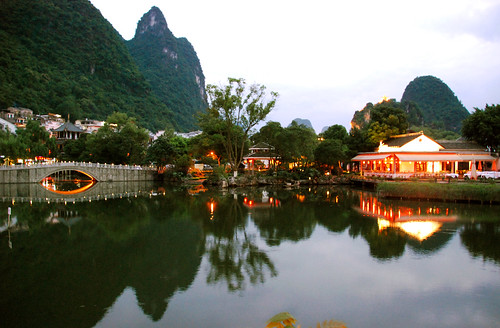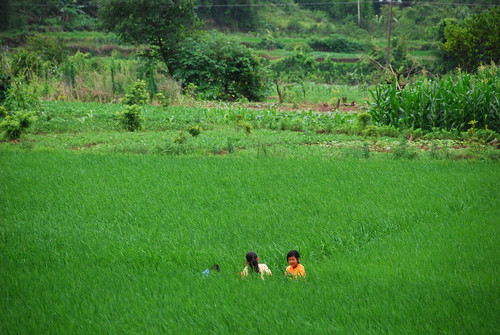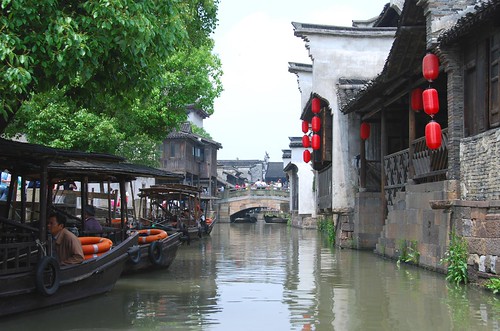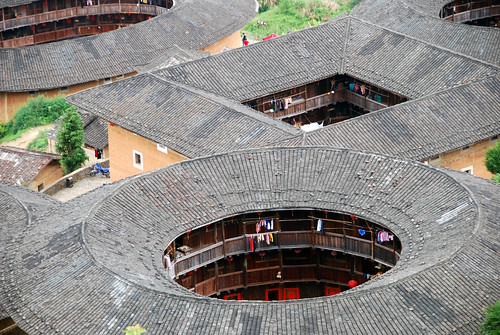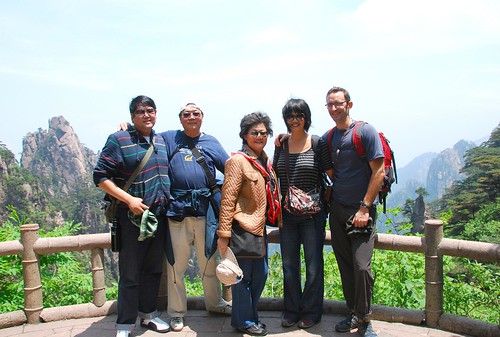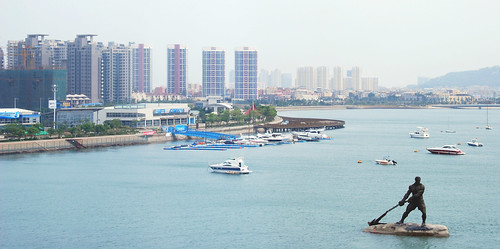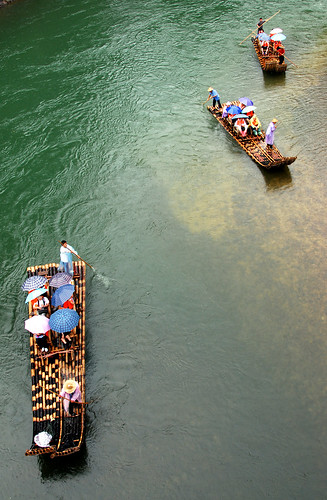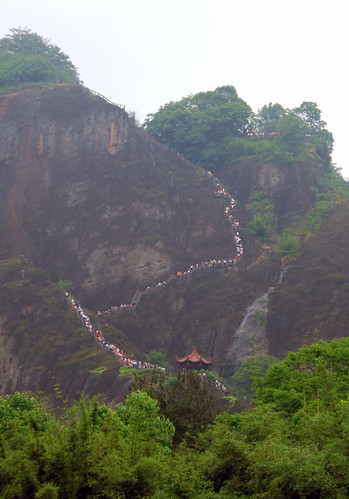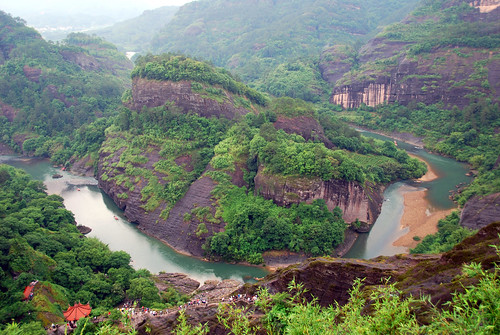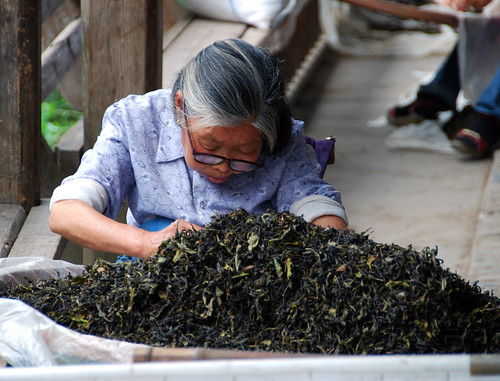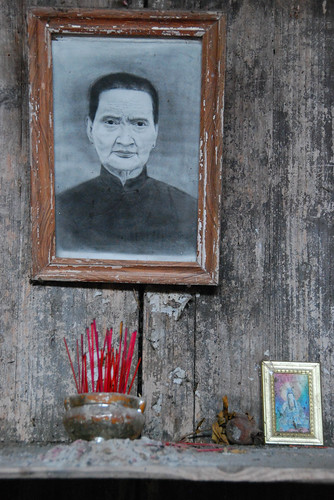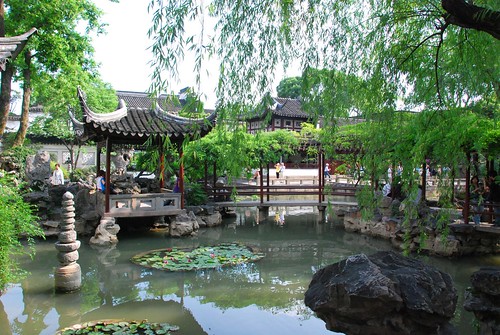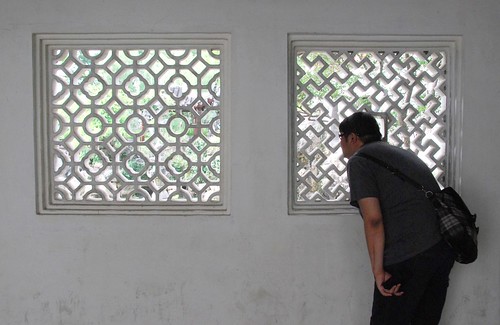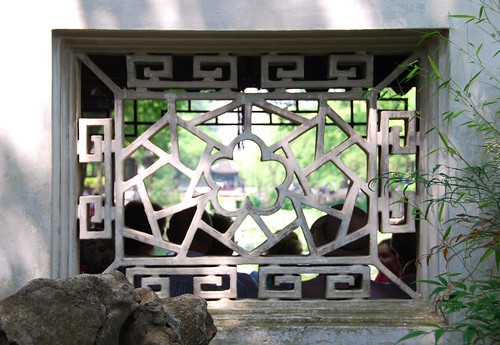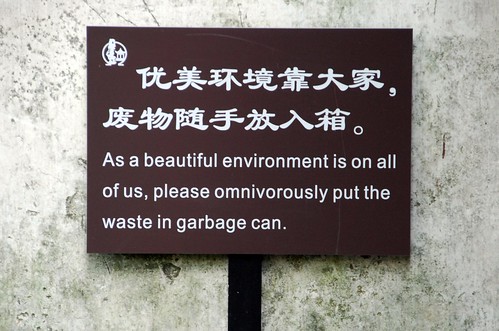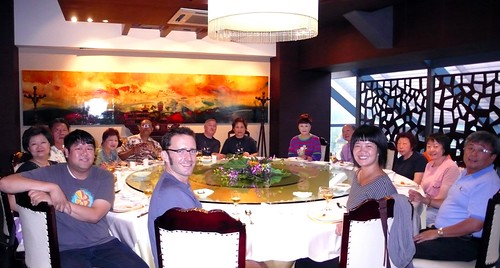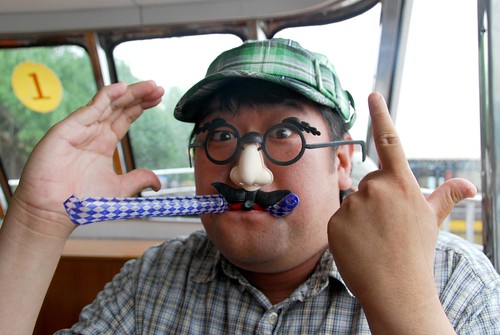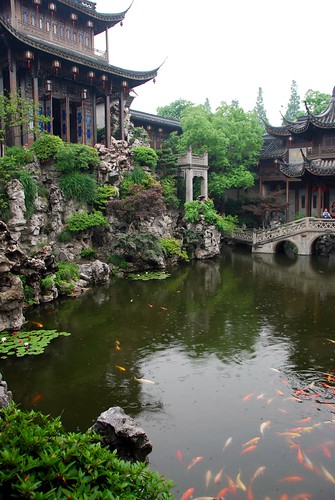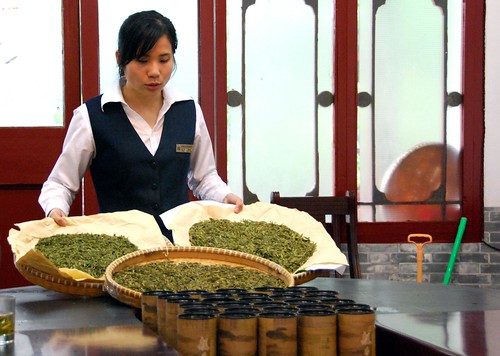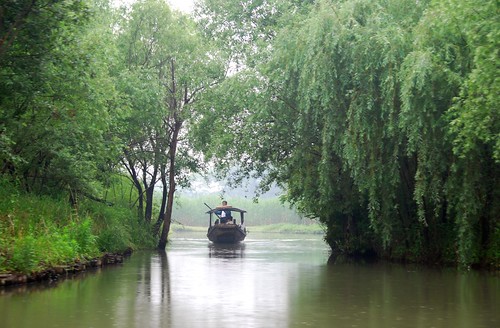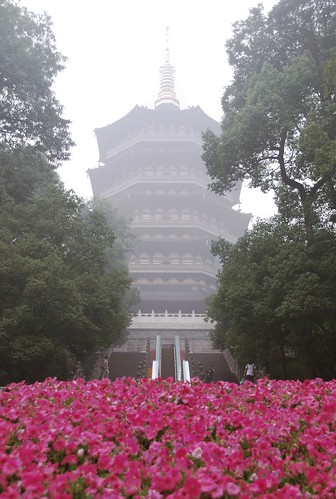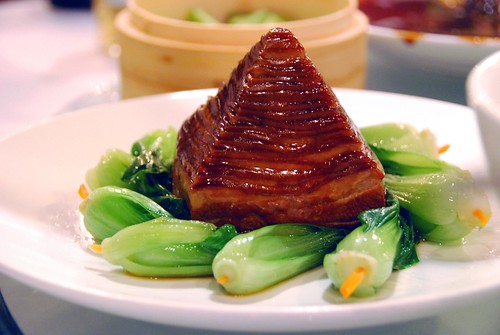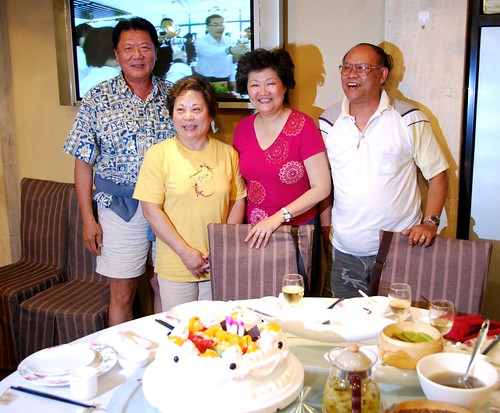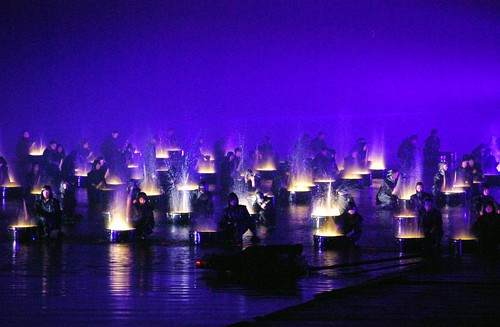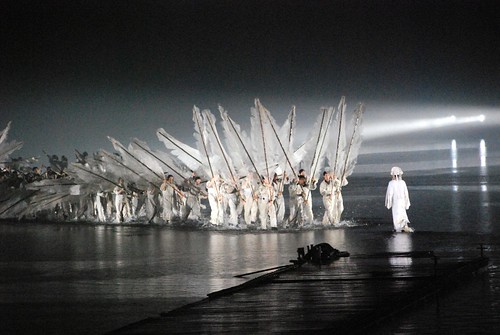Archive for June, 2009
We hightailed it out of Yangshuo and jumped on the overnight train to Chongqing, in Western China. We got on the train at 1PM and arrived in Chongqing the next morning, so we had plenty of daylight hours to enjoy the view…and what a view it was! Guangxi province has an incredible landscape…full of the same karst formations we saw in Yangshuo.
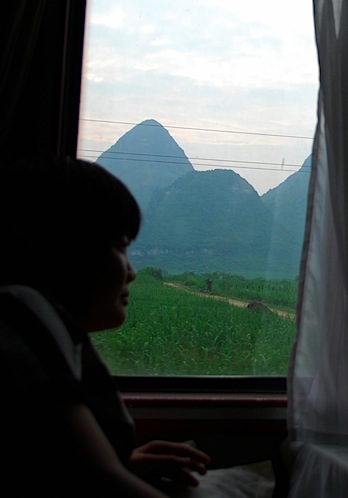
This was our first experience in China traveling “with the people,” and we saw many Chinese families en route to their various destinations.
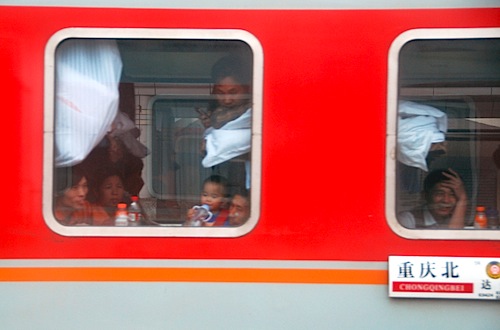
We shared our cabin with a man of 40 or so who was taking his ailing uncle to Chongqing for treatment. His tenderness towards his uncle (who he told me was “like a parent” to him) reminded me of the best aspects of Chinese culture (respect towards the elderly, filial piety, etc.), at a time when I was still stinging from experiencing its worst in Yangshuo.
You’ve probably never heard of Chongqing, and it’s not on most travelers’ radars as a destination (other than as the launching point for boat trips down the Yangzi). Actually, we wouldn’t have considered Chongqing as a stop on our trip through China, except that my aunt (Xiao Jo Ma) has an apartment there, and she insisted that we take advantage of it.
But hey, World Out There, remember that name, “Chongqing.” You will undoubtedly hear about it in the coming years. The Chinese government is pouring tons of money into this city, as an experiment in making the interior of China as successful as it’s East Coast. It’s also a way to improve the economic situation of millions of rural inhabitants by providing job opportunities. The building boom is on steroids here, a situation that is well documented in this video: http://current.com/items/88938803_city-on-steroids.htm
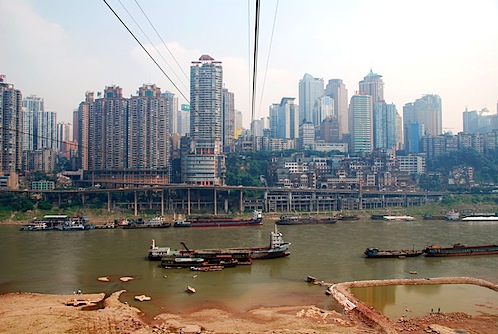
Chongqing’s Jiefangbei district, seen from across the Jialing River.
Chongqing is the fastest-growing city in the world, as rural populations flock to the city for job opportunities. Some estimates put the population at 40 million. Let that sink in for a minute: 40 MILLION. For reference, that is almost twice the number of people in the entire country of Australia. There are an estimated 1200 people moving to the city EACH DAY.
Even though my brother is the one in the family interested in urban planning, I couldn’t deny that Chongqing is a fascinating place. The scale of the city is hard to grasp, though Chongqing’s amazing urban planning museum does a good job of showing you China’s ambition:
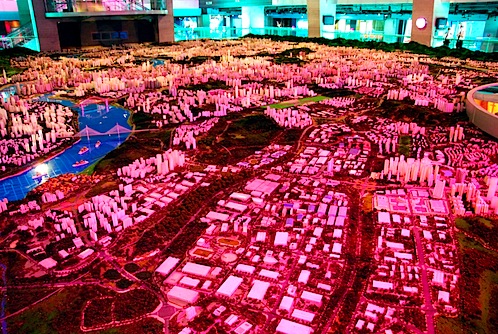
A model of Chongqing in 2010. It is hard to capture the scale here, but for reference, there are two people standing in the upper right hand corner of the photo.
Chongqing’s urban planning museum is brand new and super slick, but we couldn’t help but notice that many of the interactive computer models were broken, and letters were already falling off the displays…a poetic metaphor for the future of Chongqing.
Indeed, it seems that Chongqing’s appetite for the new and bigger is insatiable…we noticed many recently-built buildings that were already starting to fall into disrepair: perhaps poorly and hastily-built, their decay advanced by neglect. The message seems to be: rather than maintain an old building, build a new one.
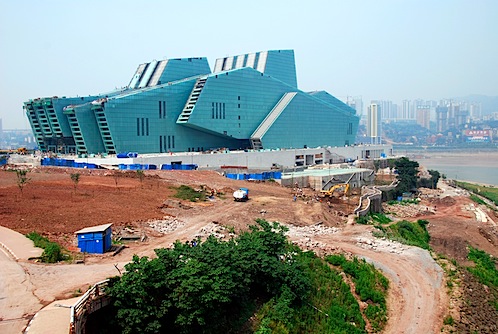
The enormous Opera House under construction in Chongqing. We think it looks like a tank.
Chongqing is a fascinating mix between the old and the new China. “Bang bang men” carry huge loads of goods on their backs up and down multi-level highrises. Former farmers sweep away construction debris with homemade bamboo brooms. These scenes seem incongruous somehow with the rapid modernity that Chongqing is currently experiencing.
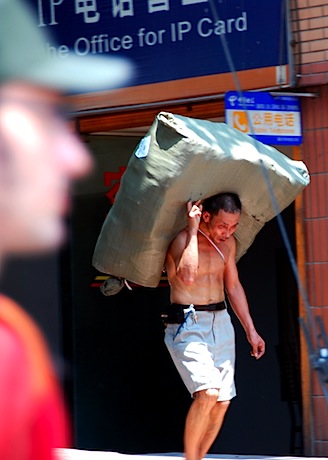
Bang-bang man with a heavy load.
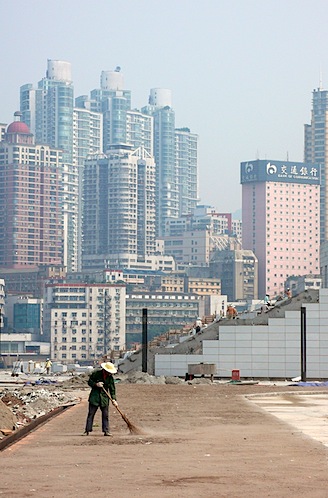
Construction worker sweeping debris with a bamboo-stick broom.
Of course, the price of all this “progress” is reflected in the environment. The air quality in Chongqing is absolutely horrible. We did not see the sun a single day we were here. It is clear that the environment cannot continue to sustain this level of development.

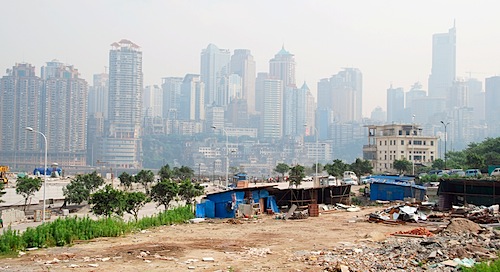
This is Chongqing.
So this is what I mean when I say, “the China we are seeing now may never exist again.” With 1200 people moving into the city each day, rapidly leaving their old, rural lives behind…China is forging ahead and not looking back. I say this without nostalgia…there is little doubt that these peoples’ lives are improved economically and it is unfair to expect them to preserve some idealized way of life for a Western audience. But as the narrator in the video I linked to above asks, when you look at the effect that this development has on the earth, is this really progress?
J and I are on our own again, and here’s where the story really gets interesting. Not that China wasn’t interesting before…it’s just that we’re now no longer on the 5-star hotel circuit. ‘Nuff said, right?
Our next destination was Yangshuo, a town near the city of Guilin in Guangxi province, famous for its karst topography. By the way, if you didn’t know, “karst” means “limestone formations.” Jeremy hates this word…he thinks it sounds ugly and abrupt, which is contrary to the word’s meaning. In fact, the karsts are quite beautiful…huge mounds of rock jutting out from the land, like some giant underneath the earth was playing Whack-A-Mole. Yangshuo is very similar to Halong Bay in Vietnam, except that Yangshuo is on land, whereas Halong Bay was in the water.
Thus far, we’ve only seen this country as part of a tour group, which, quite frankly, is a good way to ease into the chaos that is the People’s Republic of China, especially when you are coming from an orderly, polite, and developed society like Taiwan. We’ve been insulated from much of the logistics of traveling, like figuring out how to get from point A to point B, negotiating with locals trying to sell you tours or various means of transport, or trying to figure out what is OK to eat when you can only read about 35% of the menu. We’ve also had very little contact with Westerners (besides the ones on the tour), since most of the places that we went with my parents were sites on the local—not international—tourist route.
So imagine our surprise when we arrived in Yangshuo and saw wai guo ren’s all over the place! We were gawking at them like the locals gawk at Jeremy…in retrospect it would have been really funny to ask them to take a picture with us (funny to us, they probably wouldn’t find it too amusing).
Yangshuo is very much a tourist town on the Western backpacking circuit, but it is very pleasant nonetheless. You can see school kids playing ping-pong at tables set up along the Li River (which borders the busiest part of town).
Our hotel room had a view of a manmade pond where a local fisherman “fished” (I am pretty sure this was just a performance for the tourists) with his cormorants (large pelican-like birds that try to swallow the fish; a ring around their neck prevents them from doing so…allowing the fisherman to extract the fish from the cormorants’ mouths).
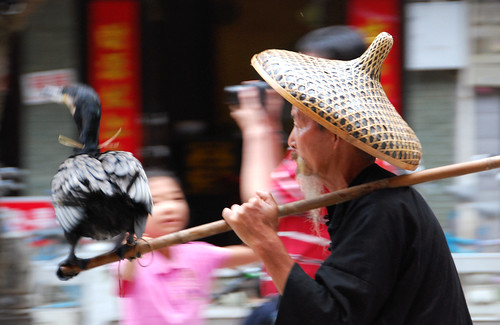
Local fisherman walking through town with his cormorant.
At night, the main street through town (West Street) becomes a night market, full of the usual trinkets (cell phone charms, fans, fake jade bracelets, backscratchers, etc.) aimed at the tourists. One weird thing we saw for sale were these airbrushed caricature t-shirts of Osama bin Laden next to Yao Ming and Obama…apparently some people in China do not consider Osama in Laden to be “bad,” they see him as a rebel, with the accompanying idolization.
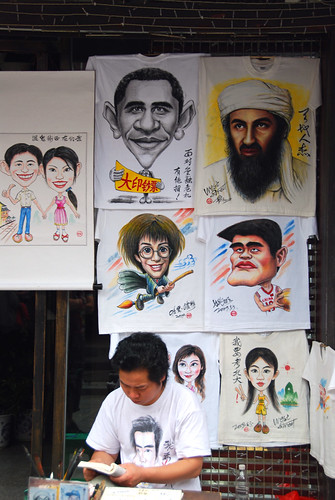
Buy your t-shirt of Obama, Harry Potter, Yao Ming, or…Osama bin Laden?
But most people do not come to Yangshuo to shop in town; it’s the karsts that are the star of the show. So we headed for Xing Ping, a smaller town a little ways up the Li River, where you can take a bamboo raft down through all those beautiful limestone molehills.
Perhaps our first indication that the day was not on our side was the weather: it was misty and drizzly that day, making our boat ride cold and wet, not to mention unscenic (the fog was too heavy that day for us to see much, though it did add a touch of drama to the events to come).
As soon as we stepped off the bus in Xing Ping, we were accosted by many touts (all women) trying to sell us a bamboo raft ride. As the walk to the pier was quite long, I struck up a conversation with one and we agreed on a price: 100 RMB (about US$15) for the ride. I tried to get her down to 90 RMB, but she then came up with a mythical “park entry fee” of 10 RMB each. If we agreed to pay 100 RMB, she would pay the park entry fee; if we wanted to pay 90 RMB for the ride, the entry fee was our responsibility. Our negotiation was quite genial, and we were laughing and joking as we walked. We settled on 100 RMB, and she and the other two ladies who were walking with us stopped to throw three wads of paper on the ground; whoever picked up the correct piece of paper would get the sale.

Two of the tout ladies in Xing Ping checking their wad of paper to see who won the sale.
Though we had negotiated with the woman on the left, the woman on the right won the sale, and she showed us to the pier, where her husband was waiting with his bamboo raft. When we arrived at the pier, another Chinese couple, who had been on the bus to Xing Ping with us, approached us about sharing their boat for only 60 RMB per couple. Our bamboo raft lady was furious, and we felt that we had given her our word, so we told the couple that we couldn’t join them on their boat.
We got on the boat and paid our 100 RMB. Two minutes after we had sailed off, the lady calls her husband and tells him that we forgot to give our extra 20 RMB “park fee.” I couldn’t believe it…we were being scammed! And by my own peoples! Now it was MY turn to be furious…not only was she increasing the price on us, but had we turned down a better deal with the bus couple to stay faithful to her! Needless to say, the ride down the river was not pleasant or interesting…the old bamboo raft man pointed out not a single point of interest (he even neglected to mention when we arrived at the “20 RMB spot”—on the back of the 20 RMB note, there is an image of Yangshuo…and yes, the irony of the fact that we were disputing over 20 RMB was not lost on us).
After a cold, wet, and uneventful raft ride, we got back to the pier, where we planned to leave without paying the 20 RMB…after I took down the man’s name (he wrote a fake name, I am sure). He followed us along the road, yelling and screaming about his 20 RMB. Finally, having had enough of this drama, I took out 20 RMB, threw it on the ground, and yelled at him in Chinese “YOU THROW AWAY YOUR FACE!” (the equivalent of “You should be ashamed of yourself!”), causing a huge scene in front of a bunch of other tourists.
I realize that 20 RMB is not a big deal, but it was the principle of the matter! Later on, we asked a couple of locals to identify the woman in the photo above so that we could report her to the local tourist office, but nobody would tell us her name. By now, my opinion of Xing Ping had been sealed…I did not like this place.
Luckily, our ugly day in Xing Ping was followed by a much nicer day biking around Yangshuo. A couple of scenes from our ride:

Lily pond in front of Yangshuo’s karst scenery.
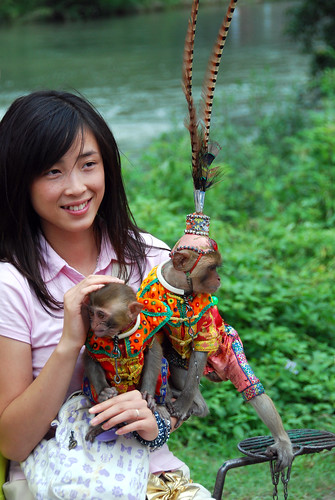
Totally random—at a park built around a 1000-year old Banyan tree, tourists can take photos with monkeys in costumes. We felt terrible for them, as they were clearly confused and terrified.
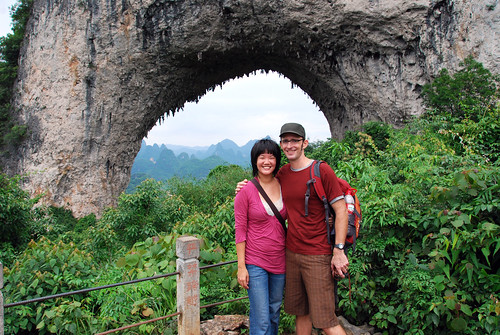
Us, at the top of Moon Hill, so named for the perfect circle (like a full moon) in the center of the rock.
We had a nice day in Yangshuo—one might even say it was a beautiful day, but I still had the bad taste of the previous day’s scam in the back of my mouth. A couple of life lessons we learned from this experience: (1) where there are Westerners in China, there are scams, and (2) just because something is beautiful on the outside, doesn’t mean it is the same on the inside. In the big scheme of things, 20 RMB was a very small price to pay to learn these lessons. But for me, Yangshuo had thrown away it’s face, and though there was much more to see in the greater Guilin area, we scurried out of there as fast as we could, eager to get the bad taste of Yangshuo out of our mouths.
* Yes, that’s really what our tour was called.
In 1986 I went to China to see my grandmother with my mom. My grandma was 90 years old and it had been 38 years since we left China to Taiwan. When I was 2 years old she took care of me for a year at Xi-An (where the terra cota statues are). I was thrilled with joy to learn that she was alive after all the hardship happened in China. Thus, my mother and I did not wait and we went to see my bed-ridden yet very sharp grandma. I went there for about 2 weeks and then stopped at Taiwan for 3 days before I came back to S. California, which was my last trip to Taiwan but the first to China as an adult.
In order to keep company with Hope and Jeremy, our whole family planned this trip to go to Taiwan first, then to travel China about 2 weeks with them together. You have seen some of the pictures and read some of the stories while we were there (including the one that I howled like Tarzan in the wild).
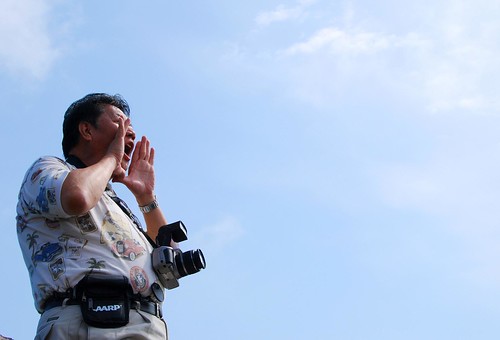
P.S. My Dad howled like Tarzan not once, but twice on this trip…the first time shown here, on Huang Shan.
Both China and Taiwan to me seem to be very foreign. Because I can’t not find the right place the easiest way. I don’t know too many people there at all. However, it didn’t take too long for me (us) getting used to the environment and learning the changing situations there. After all, I know the history, the background, the language (dialects), and traditional customs.
For our family, this is the first time for my wife (Wendy), my son (Eddo), my other son (Jeremy) to be in China. And even this is not the first time for Hope being there in China, she really does not know too much about places other than Bei-Jing. I had been to North (Bei-Jing, Shan-Xi), Manchuria (Harbin, Sheng-Yang), Yun-Nan (a beautiful province with many minority tribes), East (Hang-Zhou, Shang-Hai, etc.). But, China is a large country that there are many beautiful places with wonder sceneries and fascinating people too.
While at Huang-Shan, the colliers moved all the daily necessities from the foot of the mountain to the top by using two bamboo boards physically. At Wu-Zheng, boats are used as the main transportation means, so that everyone knows how to handle a boat (of course, now the younger generation leave town to live in the city and they probably drive a sedan now). At Wu-Yi mountain area, all women know how important life is about with tea drinking, while the girl does not tour guide to make some income, she will pick the tea stem from the leaves. Their life was very similar to their ancestors for hundred and maybe thousand years.
Han Chinese (which is the majority) are and have been agricultural for many years (or many dynasties), who are not aggressive to invade other people. But they treasure the land and will protect it with their life. When we went to visit the Hakka Mud Village Home, we felt so much for understanding the reason why they live together as a society.
Together, we spent 17 days with Hope and Jeremy (and with Eddo, 6 days). This trip has been a very rare opportunity for our family get-together. And I personally was very happy on this trip. After I got home and went to develop the pictures (over 1,000 of them), I have noticed that all the pictures I am in, I am with a smile. Some of you probably remember my crying with joy at Hope and Jeremy’s wedding. I blame the photographers catching me at “wrong time”. But on this trip, there simply were no “wrong time”. Even it has costed us some fortune for this trip, But I have to say, it definitely is worthy. And I wish there would be another one with my “children” soon.
The final stop on our two-week trip through China with my parents was Xiamen, a city located on the southwest coast of Fujian province. Xiamen is a city, but it’s very different from other Chinese cities. First of all, because Xiamen is coastal, the air quality is supposed to be quite good (though it was still pretty hazy when we were there). Second, the Chinese government has made the buses very cheap in order to encourage public transport, so there are hardly any motorcycles or bikes on the road. And finally, Xiamen is a mere 2 km away from Jinmen, a Taiwanese island (the one that was bombed throughout the 50s and 60s by the Chinese), so there is much trade and travel between the the two countries. The people of Xiamen even speak the local Taiwanese dialect.
All of this makes Xiamen feel almost like a generic big city in Taiwan, which (in general) was not really that interesting to us…but we did do a few things of note in the city proper. We checked out a memorial to a local merchant who made his fortune in Singapore and came back to his hometown of Xiamen in order to develop the city (many towns in China were developed in this way—through the benevolence of one of it’s people).
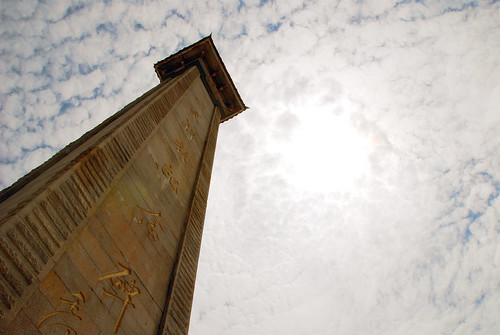
Memorial to a man who helped build universities and other public institutions in Xiamen.
And we visited the island of Gu Lang Yu, which is Xiamen’s main tourist attraction. I think all of us in the group were pretty tired at this point on the tour, so we didn’t explore too much of the island. Given more time and energy, I am sure it would have been interesting—Gu Lang Yu has an international past, with many ex-pats living on the island. Today, it is known as “Embassy Island,” with something like 100 foreign embassies squeezed onto it’s tiny body.
By far the most interesting part of our time in Xiamen was actually our visit to a place about 3 hours outside of the city, a place called Hakka House. The Hakka are an ethnic minority in the region that live in huge, communal, circular houses made out of mud, sticky rice, and stones.

View of Hakka House from above.
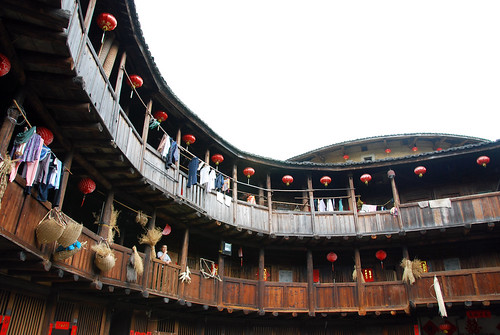
View of Hakka House from the inside.
Hakka houses are are built in a circular shape for protection from local bandits and animals. They are really big, but they house only one family…though “one family” can mean up to 4 generations of grandparents, parents, kids, uncles, cousins, etc. The first floor of a Hakka house is all kitchens, with storage on the second floor, and living quarters on the top floor. It can take years to build a Hakka house, since they are made of mud and sticky rice…you have to wait for the first floor to dry before building the next floor.
Though it has become a UNESCO World Heritage site, the Hakka House is still a functioning village. We saw many domestic scenes as we walked through the site:
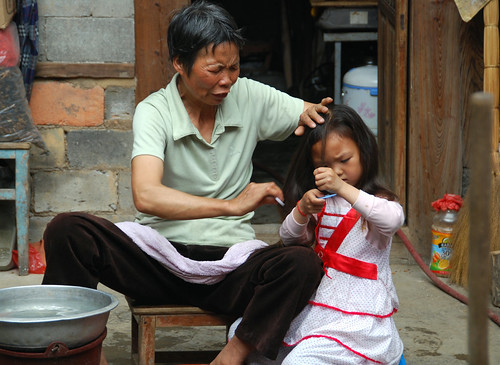
Little girl getting her hair washed by her grandmother. She was screaming and carrying on as her grandma tried to comb the tangles out of her hair.
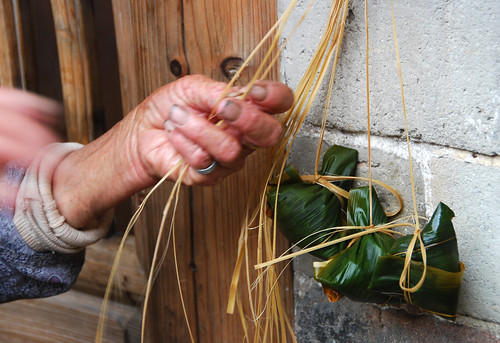
Woman with amazing hands wrapping zong zi.
Before we went to Hakka House, we stopped by a local village for lunch that was having it’s market day. We had some free time before lunch to wander around and check out all the stuff for sale: live chickens, strange vegetables, intestines hanging on meat hooks…
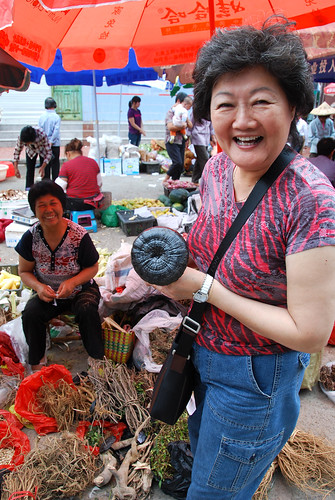
My mom with some sort of mushroom.
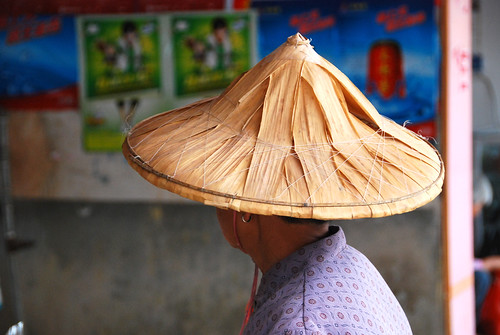
I don’t know why, but I LOVE this photo of an old lady in the market.
I really enjoyed our time at Hakka House and this local village, but our visit was far too short. Because it was a 3 hour drive from Xiamen each way, we had to hurry back for our special goodbye dinner, where we played a Xiamen dice game and ate something called “sea worm.” I have to admit, it was fun to do this eating tour with Frank, but I am not sure how much more crazy stuff we could have eaten!
In Xiamen, we said goodbye to my parents as we prepared to head our separate ways (us to Yangshuo, and my parents back to Taiwan via Jinmen). We had an incredible time traveling together with Eddo as a family, and it was truly a special experience to be with my mom on her first visit to China and with my Dad on his first visit back to Taiwan in 26 years. I feel that through this trip, I understand so much more about my parents than I did before. As I told Jeremy, “In the US, I feel like my parents are so Chinese. In Taiwan, I felt like they were Americans, and in China, I feel like they are Taiwanese!” The truth is, they are all three of those things, as am I, as is my brother. I see my parents in a new light now…I never thought of them as “international” before, but traveling through Asia with them, I see that they really are the embodiment of that word. I learned so much more about my heritage and I understand more deeply my responsibility to transmit the lessons I’ve learned from my parents and my grandparents to the next generation.
In an email, my parents described this leg of our journey as “the trip of a lifetime.” Indeed, it was a trip of many lifetimes, and of many lives convening to lead us to this place, together, as a family. Thank you, Mommy, Daddy, and Eddo for coming out to travel with us, sharing your stories, and discovering this land that is both familiar and unfamiliar to us all. We will treasure this time together for many more lifetimes to come.
After saying goodbye to Eddo in Shanghai, we headed off to Wuyi Shan (Wuyi Mountain), in Fujian province. Our introduction to Wuyi Shan was kicked off quite ceremoniously by The Scariest Dinner We’ve Had So Far. We were taken to a restaurant specializing in “local delicacies”, if by “local” you mean “scary” and by “delicacies” you mean “all breed of mountain animals.” We ate wild boar and snake and mountain toad and turtle and wild pheasant and and…the list goes on. By the end of the meal we didn’t know if we should be more scared of what dish was coming next or of ourselves!

This is what snake soup looks like.
After sleeping off our scary meal, we started the next day off with a ride on a bamboo raft.
Our bamboo raft man told us many, many jokes in Chinese (of which I understood exactly NONE). My parents had a good time, though, so that’s all that matters. Of course, Bamboo Raft Man is no match for my Dad when it comes to getting attention…as we passed through a narrow channel, my Pops made like Tarzan and howled mightily, his voice bouncing off the rocks from one end of the river to the other.
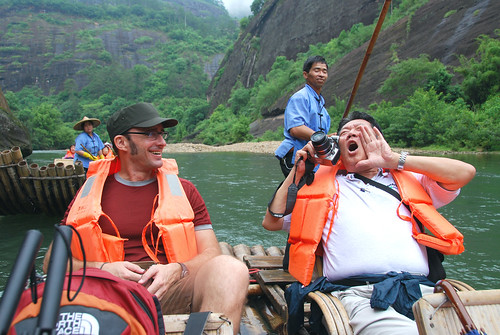
Um, is this REALLY my father-in-law?!?
As you’re floating down the river, you can see a bunch of people climbing the mountain; they look like little ants scrambling up the steep rock face.
Later on that afternoon, we did a little role reversal and WE were those little ants on the mountainside! The view from up top is stupendous, and despite the super steep climb on slippery wet rock, we all made it to the top! I was extra proud of my mom for pushing hard to make it up the mountain!
The following day, we did some more hiking near the Blue Dragon Waterfall area, which was also quite pretty.
But to me, the most interesting part of the Wuyi Shan area was the little run-down village (Xiamei) that the rest of the tour group wasn’t interested in at all. In fact, only my family walked through the entire village—the rest of the tour group turned around halfway through and waited on the bus. I guess they thought it was TOO run down and dirty, but I felt it was refreshing to see a place that wasn’t cleaned up and commercialized and polished for the tourist market.
The main drag in the village was filled with old ladies sorting tea leaves. Tea is a big cash crop for rural China, so cultivating tea is one of the major ways you can make a livable wage outside of the cities. Apparently tea sorters get paid for the number of bad leaves they pick out of the batch (not the number of good leaves they leave in!).
I liked observing the people—young and old—who lived in this town, and wondering what their lives were like: what makes them laugh? Where do they brush their teeth? What do they want to be when they grow up? Silly yet intimate questions, I guess.
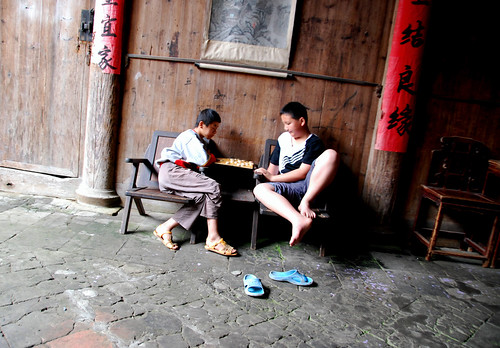
Two boys playing Chinese checkers.

Old man on the main drag in Xiamei village.
Xiamei seems a world apart from places like Shanghai. It makes you wonder…as the government puts more and more effort into improving (economically) the lives of its poorer rural residents, how long before the people of Xiamei decide to move to the cities, where they can make more money hauling loads of laundry up a multi-story building than they can sorting tea leaves? How much longer before places like Xiamei are simply a relic?
We’ve added a Resources page, covering both general travel and country-specific websites that we’ve found to be helpful. Check it out! You can also navigate from the handy menu bar at the top of this page.
Our looooong day in Hangzhou was followed by a much more leisurely morning exploring a floating village called Wu Zhen. The tour group arranged a boat trip through the village for us, which was quite picturesque and relaxing. As we floated down the canal, we saw many old homes that are still inhabited by families (as evidenced by their underwear and other laundry hanging out to dry—Chinese people are definitely not afraid of other people seeing their underthings).
As it turns out, this picturesque little village has a sad story. Wu Zhen was turned into a tourist attraction by the Chinese government, and even though visitors must pay an entrance fee, the residents do not receive any payment for the inconvenience of having hundreds of tourists filtering through their hometown on a daily basis. In fact, the people of Wu Zhen are not even allowed to vend until 4PM (when all the tour buses leave). I felt really bad for the village residents, because it was clear that their hometown had been turned into a zoo, and you could see in their faces that they were annoyed and frustrated by the constant stream of visitors coming to gawk at their “old” ways of living. As a result, I didn’t take too many photos here; I didn’t want to disturb these poor people anymore than we already were. Our tour guide explained that most of the young people had already moved out of the village; only the elderly (i.e., the people who could not afford to buy new homes) were still around. China’s incredible economic rise has brought a huge amount of prosperity to a huge amount of people, but the people of Wu Zhen have definitely been left out of that…unable to cash in on tourism even as their homes get turned into a modern-day Chinese Disneyland. China, as we are finding out, is many things, but it is almost never solely what you see on the surface.
We left for the town of Suzhou after our Wu Zhen tour, but before I get to that, I wanted to mention something else about our Hangzhou experience. This was Jeremy and I’s first time on a Chinese tour, and that in itself is an experience. Independent travel is not a big thing for Chinese—they prefer to travel in big groups, and they like the ease of a tour group; they don’t want to think about where to go next, or how to get there. You can see a Chinese tour group coming a mile away—they all (willingly) wear matching hats. Seriously, our tour guide told us that if he was taking a Chinese group around and they didn’t give them hats, everyone would change to a different tour service, saying “this crappy tour doesn’t even give you a free hat!”
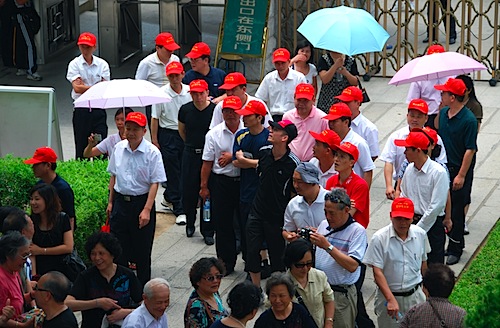
Not only can you SEE a tour group coming from a mile away, but you can HEAR them too. The matching hats are usually following a tour guide who carries a flag (usually yellow) and is screaming into a megaphone. You could be in the most serene, peaceful, natural setting, but the tour guide will be blabbering away on his/her megaphone. It’s almost like the Chinese feel they won’t get their money’s worth unless the tour guide is talking the entire time.
Our Chinese tour guides made some slight changes to accommodate our “American” group: we didn’t get hats, for example. But they still talk an awful lot (sometimes they even sing for you)—they even talk when we are sitting on the bus, in transit from sight to sight. Luckily, most of what our Hangzhou tour guide had to say was quite interesting…we found out, for example, that men in Hangzhou area of China do all the housework, in addition to earning all the household’s money. This is very unusual in China, as the country is an extremely patriarchal society. On top of that, in order to attract a bride, the man must own a home, which can cost at least 1 million RMB in Hangzhou (about US$150,000). This is not a small amount of money in China, and usually the parents help their sons buy their first house so that they have a chance attracting a desirable wife. As a result, Hangzhou is the one area in China where having a daughter is more desirable than having a son. I am not really sure what women in Hangzhou do, since they don’t work and their husbands do all the cooking, cleaning, grocery shopping, and laundry. I guess they just shop all day? As you might imagine, Hangzhou men are extremely desirable husbands in China. ![]()
OK, switching gears now to Suzhou, the garden city. Unlike the gardens in Beijing, which were built for emperors, Suzhou’s gardens were built for private citizens, so they are smaller and more intimate. We toured The Garden to Linger In the first day:
and a much larger garden (I can’t remember the name of it) the following day:

View of Leifeng Pagoda in the background. This is a feature of Suzhou gardens: incorporating background elements into the garden’s design.
My two favorite things about Suzhou’s gardens were (1) the amazing windows…each one has a different pattern, and there are hundreds of them!
And (2) Suzhou’s amazing Chinglish signs!
BTW, here’s a link to an amazing Chinglish brochure from our hotel…not to be missed!
That evening, we celebrated our final meal in China with Eddo, who was returning to Shanghai, while we went on to Wuyi Mountain. It was a lovely dinner, at a table that had to contain the world’s largest lazy susan:
The restaurant overlooked a large lake, and we got to see the huge amount of redevelopment that has gone on in Suzhou. Apparently Suzhou is following in Shanghai’s footsteps and building a large number of high rises as the Chinese economy booms.
Frank told us that he felt Suzhou has lost its charm…and it’s hard to disagree. I mean, the gardens are still there (many of them are UNESCO World Heritage sights, so they are protected), but it’s hard to imagine how that ancient way of life is going to coexist with a population that has an ever-growing appetite for the new and shiny. And if the old way of life does persist, will it just be an act? A show put on for tourists who want to come and visit “ancient” China?
Once again, if you just look a little bit deeper, you can see all the issues that China has to grapple with as they move full-steam towards modernity. China is a fascinating place at a fascinating time in its history, and it’s easy to see that the journey ahead for this huge country will involve some difficult choices…many of which are being put off for the short-term pleasure of economic prosperity.
Next stop on the Meng(hermann) Tour of China…Hangzhou, a large city most famous for its large lake, Xihu (West Lake). We met up with the Frank and the rest of the tour group here, who had already been traveling together for a few days. We got off to a great start—our first meal together was at a restaurant where every dish featured an ingredient used in Chinese medicine, which made for a delicious, healthy, and interesting meal.
We started off the following day with a cruise on West Lake. This is one of China’s most heavily touristed sites, but we had more fun taking pictures of each other in Groucho Marx glasses that I bought for 5RMB each (about US$0.50). Not only were they hilarious, but a hidden blowhole made two streamers pop out either side of your mouth like a mustache.
We all took photos with the glasses, except for Jeremy…seems that the specs are for flat little Asian faces only; the fake nose wouldn’t fit over Jeremy’s Western nose. ![]()
If you want to see the ONE photo I uploaded of East West Lake, look here.
Next we toured an old Chinese house, built by a rich, famous Hangzhou merchant. It was quite opulent, with blue glass windows (unusual in China) and an enormous garden with a koi pond. This estate was very different from the houses we saw in Hongcun and Xidi. Similar to today, it seems that the closer you are to the ocean in China, the richer you can be (though with all the money the Chinese government is currently pouring into the inland cities of Chengdu and Chongqing, this is changing).
As I mentioned previously, on these organized tours, your days are jam-packed with activities. By noon, we had already accomplished what Jeremy and I would consider a full day of sight-seeing activities. But we had much more in store. Next up was a visit to a local, government-owned teahouse. Hangzhou is famous for its Dragonwell green tea, and we were all ushered into a tasting room to learn about the different health-inducing properties of this tea. The woman conducting the tasting was an AMAZING salesperson…she explained the difference between spring, summer, and autumn-harvested tea (spring is best; summer and autumn-harvest leaves are the crappy ones used in teabags), and even let us see and smell the difference for ourselves (spring tea is actually lighter in color than summer and autumn tea).
She explained the difference between A, AA, and AAA grade leaves (they are all spring-harvest leaves, but AA leaves are the small leaves picked from the top of the bush, and AAA leaves are picked from bushes that grow in the wild). AA leaves are about twice as much per kilo as A leaves, and AAA leaves are 4 times as much…but according to the saleslady, you need twice as many A leaves as AA leaves to make a single glass of tea, so the increase in price is moot (a convenient sales tactic).
We learned a lot about tea at this tasting, but it was far more interesting was watching this saleslady do her thing. I have never seen a salesperson with powers as fierce as hers…she knew EXACTLY what to say to convince everyone of the powers of this Dragonwell tea. The pinnacle of her pitch was a demo where she coated some grains of rice with iodine and then tried to wash the iodine off with water (of course, the sludgy brown stuff would not budge). Then, she poured a glass of Dragonwell tea into the cup with the sludgy grains, and the rice turned completely white again (the implication being that this is what the tea will do inside your body—remove the toxins and scrub your insides as clean as a grain of shiny white rice). We learned that with Dragonwell, we should use cold water to make the tea; hot water kills all the polyphenols. She flowed imperceptibly between the demo and the selling portions of the afternoon, and by the time she was ready to sell, everyone was eagerly whipping out their wallets.
The force was strong in her, but she was no match for Chou Mama, the eldest lady on our tour. Chou Mama had about 60 years of bargaining skills on the saleslady, and she used her considerable skills to slowly but surely bargain the sale price down lower and lower. It was like the Clash of the Titans, and we had front row seats!
After we all left with kilos of tea, we took a boat tour of a swampland area, which was quite beautiful and relaxing:
And then toured the beautiful Leifeng Pagoda near West Lake:
But wait, there’s more…we also had an amazing dinner that featured a BACON pyramid, and we celebrated four different May birthdays: my Mom and Dad’s and two other people on the tour with us (Mark and Dolores).
And finally, we ended the looong day by seeing the Impressions West Lake show, directed by Zhang Yimou (the famous Chinese film director who also created the Beijing Opening Ceremonies). The show was the performed ON West Lake (actually on the water), and it retold the tale of a ancient Chinese love story.
The show was visually stunning, but if you are not familiar with the Chinese myth, it can be hard to follow the story, as it is told in a very abstract way. Also, I guess because Jeremy and I had been blown away by the Olympics Opening Ceremony, we thought that the West Lake show would be a lot tighter. Still, it was an excellent experience and you can’t beat seeing a show that is performed ON a body of water.
SCHWOO! It was a long but fulfilling day, and we went to bed happy to have gotten a lot out of Hangzhou.
After two beautiful days spent on Huangshan, we headed down the mountain and drove through Anhui Province’s gorgeous countryside towards two historical villages: Hongcun and Xidi. Though the two villages are clearly set up for tourism now, they still offer a glimpse into how life was once (and, to an extent, still is) lived in China.
In order to enter Hongcun, visitors must cross a long bride over a wide manmade lake:
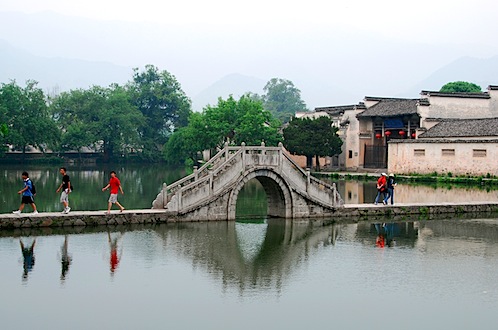
Our tour guide explained that the waterways in this village are quite symbolic: Hongcun’s village plan is built to resemble an ox, with it’s lakes and narrow aquaducts symbolizing the animal’s intestines. A bird’s eye view of Hongcun bears no resemblance to any ox we know of; I guess the village plan is really just an allusion or a metaphor?
At the center of Hongcun is Moon Pond, a crescent-shaped body that is the ox’s “stomach.” Scenes from Crouching Tiger Hidden Dragon were filmed here.
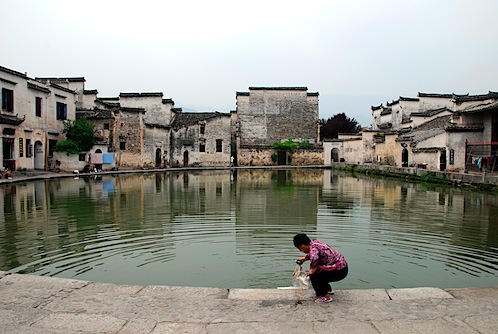
In old China, many villages only housed one family of people; Hongcun was home to the wealthy Wang clan of merchants. Towns consist of private homes as well as temples, where members can go to pay homage to ancestors or gods. We wandered in and out of many old buildings, and saw beautiful carved wood doors and stone fixtures.
But by far the most charming part of Hongcun was the village’s narrow, winding alleys and unexpected views into village life.
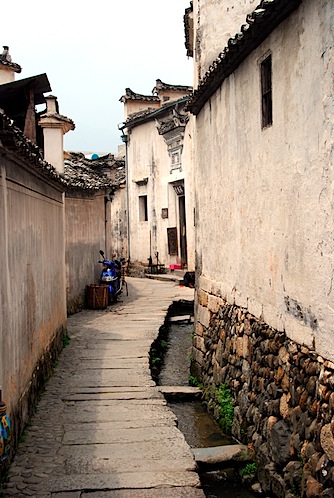
Hongcun’s narrow alleys and waterway “intestines.”
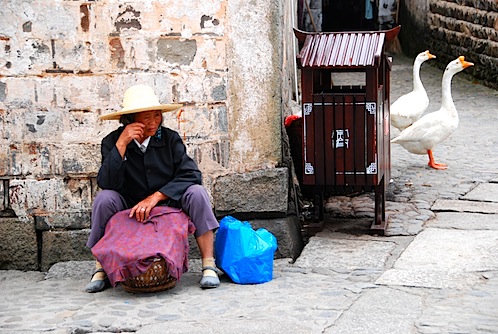
Old vendor lady and geese.
We enjoyed a lovely and delicious lunch at a local farmer’s house, set in an old estate amongst a bamboo forest.
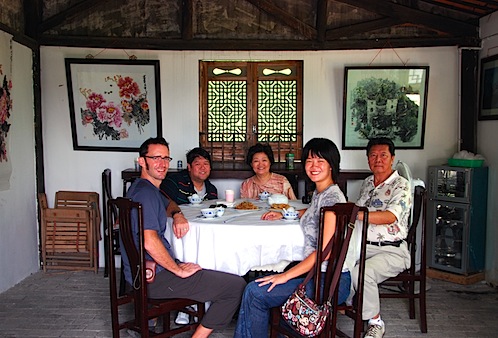
In comparison, Xidi was not as quick to charm, though upon closer inspection, there were many details that caught my eye: a window displaying disintigrating Chinese paper cuttings…
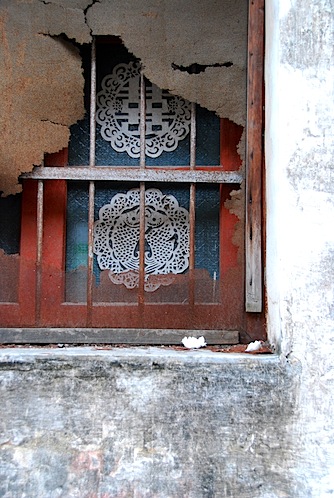
…wooden doors with a surprisingly modernist design (this pattern is apparently meant to look like the cracks in frozen ice):
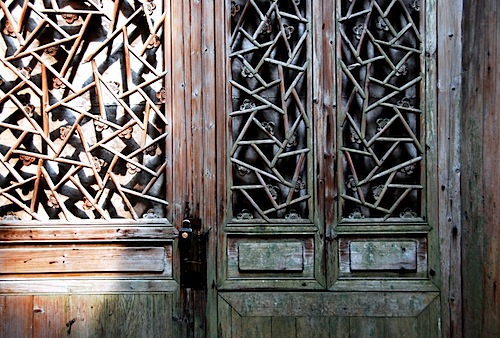
…and an antiques dealer selling vintage locks:
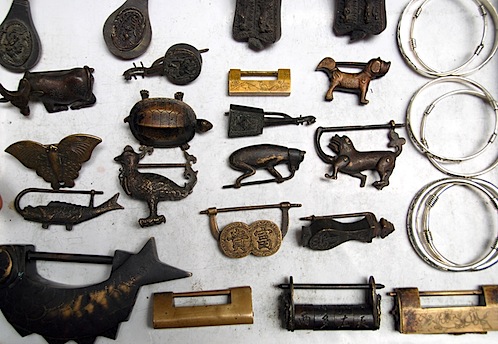
Note the animal-shaped locks; you put a key in the monkey’s/dog’s/lion’s butt to open the lock. Also, the lock in the bottom row, second from the right is an old combination lock using words rather than numbers—you dial in a phrase to unlock its secrets.
It really was a fine day spent enjoying Anhui’s historic villages. We ended with an extensive tea tasting at one of the local teahouses:
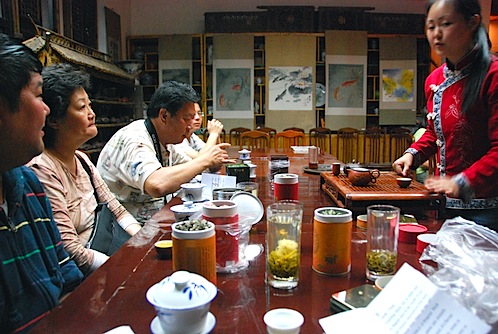
And ate a nice dinner, followed by a birthday cake for my mom, who celebrated her 59th year of life by visiting China for the first time!
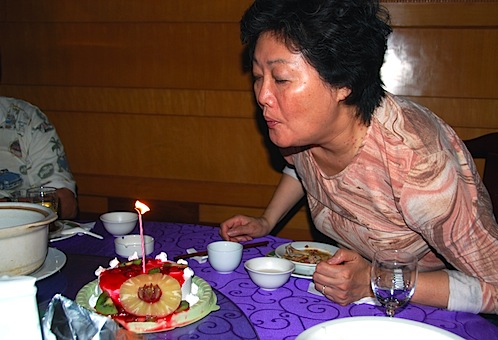
Anhui Province is one of the (if not THE) poorest province in China, but from what we saw, it is also one of the most beautiful. Like my own birthday in Sapa, I am sure this is one celebration my Mom will remember for a lifetime. ![]() Happy Brithday, Mom!
Happy Brithday, Mom!
Note: Hey everyone, let’s give a warm welcome to Eddo! My little bro shares his thoughts as the family travels Huangshan…I love that even though this post is about a mountain, he manages to nerd out on urban planning. Kudos, Eddo! ![]()
As an urban planning nerd/activist, I’ve always been interested in the growth and history of cities. Why did this particularly scenic peninsula morph into modern-day San Francisco? How did the end of the Mississippi River support a multi-ethnic creole population like New Orleans? How did two tiny islands in the middle of the Seine River become a focal point for a global city? How did civilization in the past evolve into its current form, and how do our actions today determine tomorrow’s society?
Anyways, enough of this urban speculation—I promise I’ll get back to it later—let’s get to the heart of this entry. Huangshan (in English, “Yellow Mountain”) is located in the Anhui province of China, and is a major mountain range which has been opened up for tourism. It has inspired countless Chinese poems, literature, and paintings, and deservedly so, because it is one of the most scenic and beautiful places I’ve ever personally experienced.
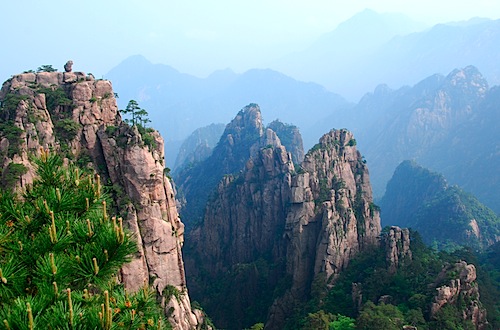
Monkey Rock (the little rock perched on top of the huge stone on the left) overlooking the Valley.
I’ve never been to China before, let alone Huangshan. The last time I was remotely close to China was probably when I was 6 or 7 years old, and was in Taiwan for my Da Jo Jo’s and Da Jo Ma’s wedding. I don’t really recall much from that time, except I liked riding on my youngest uncle’s motorcycle/scooter, and that it was really hot. So for me, Huangshan was not only an eye-opening experience, but also my introduction to China.
China’s problems with rapid modernization and urbanization are well-documented, and I don’t think I need to go into too much detail, but to be introduced to China via its rural and agricultural communities, is, in a word, refreshing. We in America like to glorify a simpler time—when seasonality and locality weren’t just buzzwords for haute cuisine, when communities and societies flourished not because of economic indicators like GDP and inflation rates, but instead on the reliance of individuals in each community to provide a good or service necessary to its citizens. And this is what China is about, I think. Despite its rapid modernization, at the core of all production is people—roads are created by people moving around rocks in wheelbarrows, crops are planted by people leading water buffalo through a field. The concept of labor here is unlike America, where machines have taken over the most difficult of tasks. If there is a resource that China has utilized more so than any other country, it is its people. Performances like the Beijing Olympics Opening Ceremony requiring massive amounts of people, control, coordination, planning, and creative vision, could not have happened anywhere else in the world. Of course, this is both a positive and negative—things are built or created at a frenetic place, but the value of human labor is less than in other countries and services rendered by humans cost exponentially less than anywhere in the West. People are valued less as specialized individuals as they are cogs in a well-oiled economic machine.
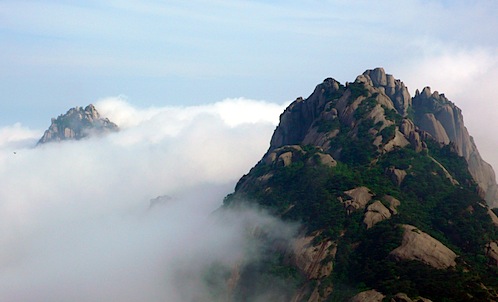
Huangshan’s famous “cloud ocean.” It literally moves in and out in minutes.
Walking through Huangshan is a series of stone steps and pathways meandering along streams, cliffs, forests, and valleys. It is stunning. But you do get a sense of devaluation of individual labor. Couriers or porters carry up all goods that are used by the hotels at the top of the mountains (Ed. note: Indeed, supplies are not allowed to be hauled up the mountain on the gondola—even though it is surely cheaper to mechanize the delivery of these goods—in order to create jobs for local farmers who otherwise wouldn’t be able to earn a decent wage), luggage from tourists, and in some cases, people who cannot walk up or down the grueling paths of the mountain. It is incredible—I can’t imagine the amount energy or labor involved. They get paid by the kilo, and generally balance inhuman amount of goods on a single bamboo stick on their back. Our tour guide told us that they can make up to 1,000 RMB a month (around US$150) which is actually a decent salary in their area. Individuals who work in the hotels on the top of the mountain stay up there for three months at a time, and get free room/board while earning salary.
I don’t know how old the trails and steps of Huangshan are, but one does get a sense of how civilization and societies emerged in the olden days. Locations were picked based on geographic resources, and paths were then created to connect major population centers with each other. Much like cities in America developed along the Mississippi River from Chicago down to New Orleans due to geography and natural resources, I imagine this is how “cities” developed in Huangshan. Except in Huangshan, these “cities” are essentially outdoor plazas with hotels and restaurants, instead of actual cities. But these gathering places and webbed network of paths towards peaks and valleys and sights are in a sense, a microcosm of China, where cities are connected to each other by a network made up of boats, rail, roads, and planes rather than stone steps.
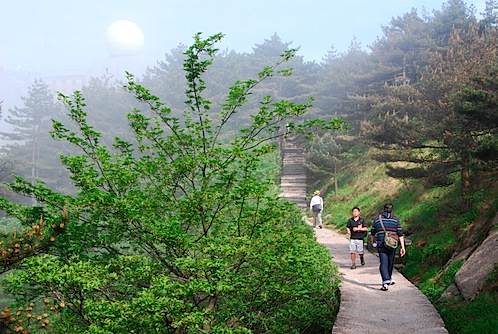
Eddo hiking towards the giant golf ball (on the left, in the background), a weather station located at Huangshan’s highest point.
Huangshan, much like the rest of China, encompasses a scale that I can barely comprehend. It is stunning. It is dramatic. It is imposing and it is spectacular. It is filled with jagged peaks, intense sunrises (which we woke at 4:30 for, climbed up a mountain and after concluding we wouldn’t see it, started hiking back down the mountain, only to see the sun peak through the trees, d’oh!), and ancient trees and wildlife. The Chinese have a saying that Huangshan is number one—after experiencing Huangshan, you need not experience any other mountains. My mother, who was also experiencing China for the very first time (she was born in Taiwan and because of China’s irregular rules on tourism during the Mao era, she hasn’t been able to visit until China became more open in the years after Mao’s death and China’s embrace of capitalism) celebrated her birthday on top of Huangshan. She said “I had always heard of Huangshan ever since I was a little girl but was never able to experience it firsthand until now. I cannot believe that I am celebrating my birthday here. I am so happy.” I think we’d all agree—there is no experience like Huangshan in the world, and despite what you may think about China politically, Huangshan is not just a Chinese treasure, but a treasure for the world.
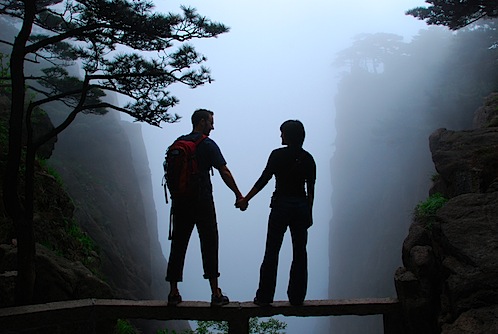
P.S. Here is a link to Eddo’s photos of Huangshan on his Facebook.
